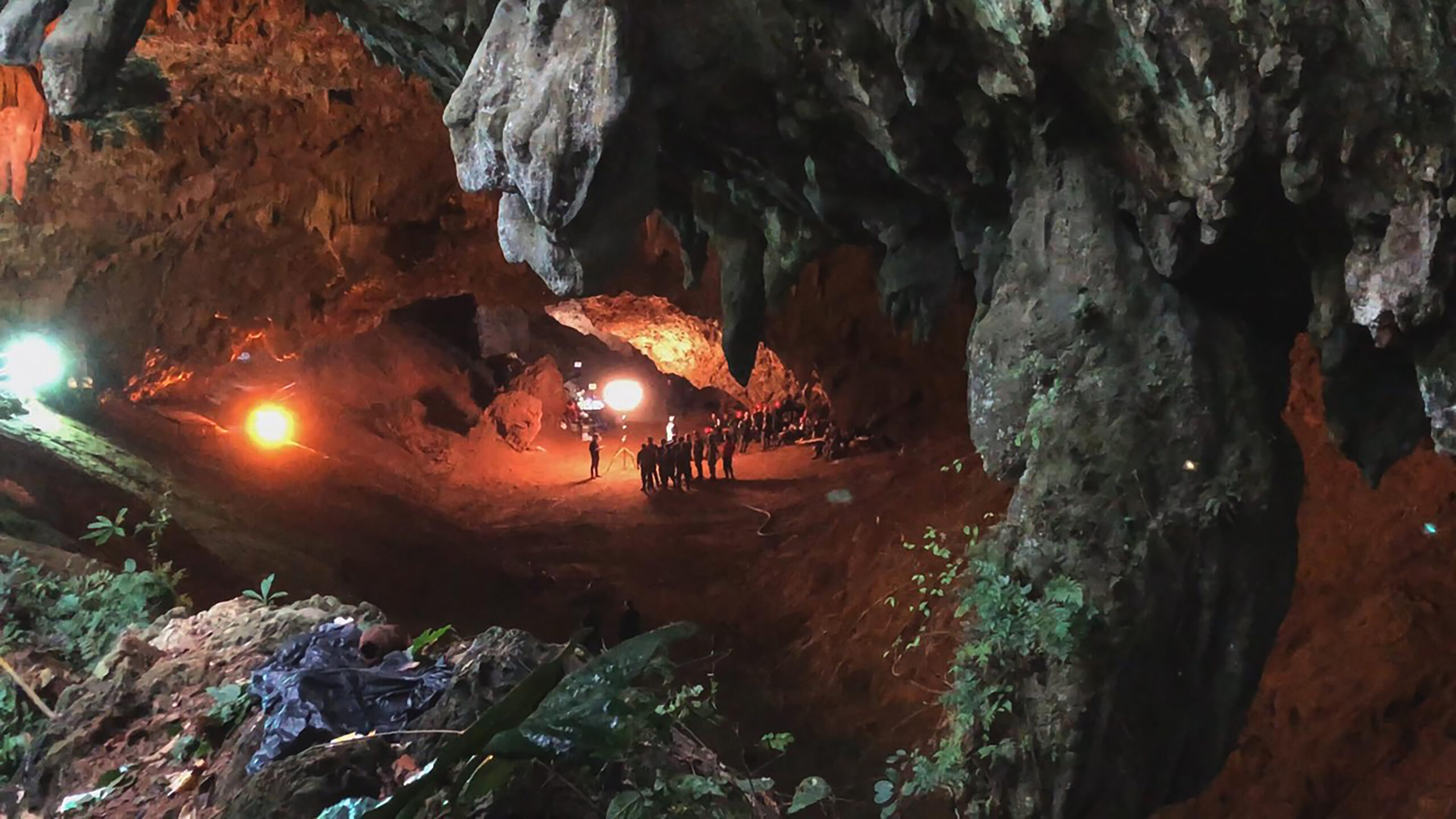
Tham Luang Nang Non, or “Great Cave of the Sleeping Lady” is a cave system near the border of Thailand and Myanmar, a cave that routinely floods during the monsoon season. In July of 2018, as you, a citizen of the world not living under a rock are no doubt aware, twelve boys and their soccer coach were exploring the cave and became trapped by one such monsoonal flood. The incident became the focus of an international rescue effort that captivated the attention of the world. The story of the rescue, of course, needs to be retold, celebrated and documented for posterity.
That’s one of the great functions of documentary film. It can capture a moment in time and freeze it for future generations. I always look forward to documentaries about newsworthy events because it provides a locus of focus and attention around which the event can be reflected upon, marveled over and remembered while all of the little details that we may have missed in the news coverage are filled in. Of course, there are challenges that face a filmmaker tasked with the job of telling a story we already know.
Since the event garnered so much attention, the coveted rights to the story were involved in a bidding war. Netflix won the exclusive rights to the tale of the twelve boys, and National Geographic, who produced the film in question today, The Rescue, secured the rights to the version of the divers involved in the operation. Thus it was that the academy award−winning husband and wife filmmaking duo, Jimmy Chin and Elizabeth Chai Vasarhelyi were quested with the gargantuan task of securing and sifting through hours and hours of footage in order to do justice to this near miraculous event. Some might consider the fact that Chin and Vasarhelyi were not allowed to interview the boys themselves an unfortunate hindrance to the story, but instead, the focus on the character, temperament, and heroism of the divers gives the film a profundity and a depth that might not otherwise be present had this limit not been artificially imposed. Sometimes it is, ironically, the random imposition of limits that bring about greater insight in the work (and besides, we will get the Netflix version of the story from the point of view of the boys in due time).
While the average film viewer most likely knows the outcome of the story, the exploration of this unassuming, mostly middle−aged group of volunteer cave diver hobbyists (who responded to the call of need and risked their lives in service of the cause) adds layers of meaning intrigue to this known event. What kind of person, you might ask, ventures into self−described “muddy holes” in the ground with scuba gear, squeezing through tiny cracks and passageways into the depths of the darkness… for fun? And how is it that this particular cultivated skill was necessary at this time and place, as if each of these men had been practicing and preparing for this moment their whole lives? When it became clear that the elite Thai Navy Seal team had run out of options, the enthusiasts’ rare and specialized skill set became the only hope for the stranded boys. Thus the call was issued, and answered by this ragtag group. The film allows us to catch a glimpse of what true heroism looks like.
In the 20th century, the phrase “the banality of evil” was coined to denote a particular phenomenon: real life villains don’t look or act like cartoon villains or James Bond nemeses. After this film, we might want to start talking about “the banality of heroism.” What these divers pulled off, of course, was absolutely incredible. But it wasn’t so much, super−human as it was faithful to the habit and skill-set that each of them had cultivated over years of practice. As it turns out, you don’t have to be a Hercules to be a hero, you just have to answer the call when your unique talent and giftings are needed.
Tham Luang Nang Non, or “Great Cave of the Sleeping Lady” is a cave system near the border of Thailand and Myanmar, a cave that routinely floods during the monsoon season. In July of 2018, as you, a citizen of the world not living under a rock are no doubt aware, twelve boys and their soccer coach were exploring the cave and became trapped by one such monsoonal flood. The incident became the focus of an international rescue effort that captivated the attention of the world. The story of the rescue, of course, needs to be retold, celebrated and documented for posterity.
That’s one of the great functions of documentary film. It can capture a moment in time and freeze it for future generations. I always look forward to documentaries about newsworthy events because it provides a locus of focus and attention around which the event can be reflected upon, marveled over and remembered while all of the little details that we may have missed in the news coverage are filled in. Of course, there are challenges that face a filmmaker tasked with the job of telling a story we already know.
Since the event garnered so much attention, the coveted rights to the story were involved in a bidding war. Netflix won the exclusive rights to the tale of the twelve boys, and National Geographic, who produced the film in question today, The Rescue, secured the rights to the version of the divers involved in the operation. Thus it was that the academy award−winning husband and wife filmmaking duo, Jimmy Chin and Elizabeth Chai Vasarhelyi were quested with the gargantuan task of securing and sifting through hours and hours of footage in order to do justice to this near miraculous event. Some might consider the fact that Chin and Vasarhelyi were not allowed to interview the boys themselves an unfortunate hindrance to the story, but instead, the focus on the character, temperament, and heroism of the divers gives the film a profundity and a depth that might not otherwise be present had this limit not been artificially imposed. Sometimes it is, ironically, the random imposition of limits that bring about greater insight in the work (and besides, we will get the Netflix version of the story from the point of view of the boys in due time).
While the average film viewer most likely knows the outcome of the story, the exploration of this unassuming, mostly middle−aged group of volunteer cave diver hobbyists (who responded to the call of need and risked their lives in service of the cause) adds layers of meaning intrigue to this known event. What kind of person, you might ask, ventures into self−described “muddy holes” in the ground with scuba gear, squeezing through tiny cracks and passageways into the depths of the darkness… for fun? And how is it that this particular cultivated skill was necessary at this time and place, as if each of these men had been practicing and preparing for this moment their whole lives? When it became clear that the elite Thai Navy Seal team had run out of options, the enthusiasts’ rare and specialized skill set became the only hope for the stranded boys. Thus the call was issued, and answered by this ragtag group. The film allows us to catch a glimpse of what true heroism looks like.
In the 20th century, the phrase “the banality of evil” was coined to denote a particular phenomenon: real life villains don’t look or act like cartoon villains or James Bond nemeses. After this film, we might want to start talking about “the banality of heroism.” What these divers pulled off, of course, was absolutely incredible. But it wasn’t so much, super−human as it was faithful to the habit and skill-set that each of them had cultivated over years of practice. As it turns out, you don’t have to be a Hercules to be a hero, you just have to answer the call when your unique talent and giftings are needed.

Justin Wells is a documentary filmmaker and author. Find more of his work at justinwellsfilms.com.
In How to Film Truth, Justin Wells explores the history of documentary filmmaking as a search for truth by filmmakers, and a journey of discovery for subjects and audiences.